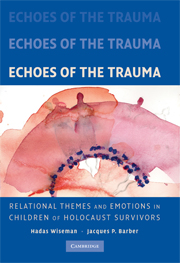Book contents
- Frontmatter
- Contents
- Foreword by Dan Bar-On
- Preface
- Acknowledgments
- 1 Introduction – A Narrative Approach to Bridging the Gap between Clinical Case Studies and Empirical Research on Children of Holocaust Survivors
- 2 Studying Relationship Narratives with the Core Conflictual Relationship Theme Method
- PART ONE RELATIONAL THEMES IN THE NARRATIVES
- PART TWO EMOTIONS IN THE NARRATIVES
- PART THREE HEALING TRAUMA IN THE CHAIN OF THE GENERATIONS
- Appendix
- References
- Index
2 - Studying Relationship Narratives with the Core Conflictual Relationship Theme Method
Published online by Cambridge University Press: 29 July 2009
- Frontmatter
- Contents
- Foreword by Dan Bar-On
- Preface
- Acknowledgments
- 1 Introduction – A Narrative Approach to Bridging the Gap between Clinical Case Studies and Empirical Research on Children of Holocaust Survivors
- 2 Studying Relationship Narratives with the Core Conflictual Relationship Theme Method
- PART ONE RELATIONAL THEMES IN THE NARRATIVES
- PART TWO EMOTIONS IN THE NARRATIVES
- PART THREE HEALING TRAUMA IN THE CHAIN OF THE GENERATIONS
- Appendix
- References
- Index
Summary
THE CORE CONFLICTUAL RELATIONSHIP THEME METHOD
The Core Conflictual Relationship Theme (CCRT) method was de veloped by Lester Luborsky in the late 1970s (Luborsky & Crits-Christoph, 1998) as a way to formulate and formalize core conflicts or central issues. These formulations can then become components of a larger and more comprehensive dynamic formulation of the patient's problems. Since that time, this method of assessing central relationship patterns has received a great deal of research attention. In fact, some of the original research was compiled into a book edited by Luborsky and Crits-Christoph.
The origins of the CCRT method are firmly rooted in clinical experience and close observation. Luborsky (1977) realized that the data he used to formulate the patients' central conflict was derived from patients' spontaneous narratives about their interactions with other people. He also noticed that his formulation of the central relationship pattern contained three components: What the patient wanted or desired from the other person (Wish), how the other people reacted (Response of Other – RO), and how the patient, or “self,” reacted to their reactions (Response of Self – RS).
The following example of a CCRT formulation is provided by McAdams: “A man's first memory was that of being held in his mother's arms, only to be summarily deposited on the ground so that she could pick up his younger brother. His adult life involved persistent fears that others would be preferred to him, including extreme mistrust of his fiancée” (McAdams, 1990; p. 441).
- Type
- Chapter
- Information
- Echoes of the TraumaRelational Themes and Emotions in Children of Holocaust Survivors, pp. 13 - 24Publisher: Cambridge University PressPrint publication year: 2008



